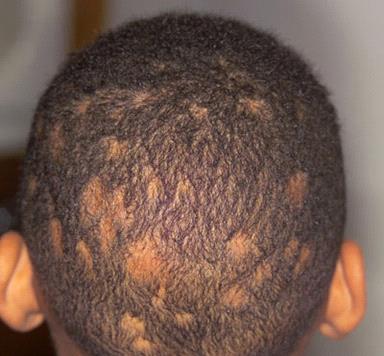Ringworm, Scalp (Tinea Capitis)
OVERVIEW
Scalp ringworm (tinea capitis) is a common mild infection of the scalp and hair that appears as scaly spots and patches of broken hair on the head. Caused by a fungus, it is most commonly seen in children.

Scalp ringworm may be passed among humans by direct contact with infected people or with contaminated objects (such as combs, pillows, and sofas). Less commonly, the fungus may be spread from infected animals (especially cats or dogs) or from the soil. Though several different types of fungus may cause scalp ringworm, they are generally known as dermatophytes.
WHO'S AT RISK
Scalp ringworm may occur in people of all ages, of all races, and of both sexes.
However, scalp ringworm is most frequently seen in children, especially those between 3 and 7 years old. Also, it is slightly more common in boys than in girls.
SIGNS AND SYMPTOMS
The most common locations for scalp ringworm include:
- Scalp
- Eyebrow (rare)
- Eyelashes (very rare)
Scalp ringworm appears as one or more round to oval areas covered with gray sheets of skin (scale) and is often accompanied by hair loss. The patches may be red and inflamed, and small pus-filled bumps (pustules) may appear. Also, tiny black dots may appear on the surface of the scalp, consisting of broken hairs.
Certain areas (lymph nodes) at the back of the scalp, behind the ears, or along the sides of the neck may be swollen.
One complication of scalp ringworm is a kerion, which is a large, oozing, pus-filled lump. If not treated aggressively, a kerion can lead to scarring and permanent hair loss.
Scalp ringworm is usually itchy.
SELF-CARE GUIDELINES
There are no effective self-care measures to treat scalp ringworm.
To prevent scalp ringworm:
- Have your child avoid close contact with infected people and pets.
- Teach your children about the dangers of sharing combs, brushes, hats, and hair accessories with friends.
WHEN TO SEEK MEDICAL CARE
See your child's doctor or a dermatologist if he or she has hair loss or itchy, scaly spots on the scalp.
If a close contact of your child (sibling or classmate) is diagnosed with scalp ringworm, make sure you examine your child's scalp by looking for scaly spots. If you are suspicious about an area, take the child to see a doctor for an examination.
If your child is diagnosed with scalp ringworm, have any household pets evaluated by a veterinarian to make sure that they do not also have a dermatophyte infection. If the veterinarian discovers an infection, be sure to have the animal treated.
TREATMENTS
To confirm the diagnosis of scalp ringworm, the physician might scrape some surface skin scales onto a slide and examine them under a microscope. This procedure, called a KOH (potassium hydroxide) preparation, allows the doctor to look for tell-tale signs of fungal infection.
Sometimes the doctor will also perform a culture in order to document the presence of fungus or to discover the particular fungus that is causing the scalp ringworm. The procedure involves:
- Plucking a few hairs from involved areas of the scalp
- Rubbing a sterile cotton-tipped applicator across the skin to collect scale and any pus
- Sending the specimen away to a laboratory
Scalp ringworm is treated with oral antifungal medicines because the fungus invades deep into the hair follicle, where topical creams and lotions cannot penetrate. Scalp ringworm usually requires at least 6–8 weeks of treatment with oral antifungal pills or syrup,
Often, the doctor will also prescribe a medicated shampoo to reduce the risk of spreading the scalp ringworm to someone else.
Occasionally, untreated scalp ringworm seems to heal on its own when a child reaches puberty.
Source: http://www.skinsight.com/child/tineaCapitisRingwormofScalp.htm

